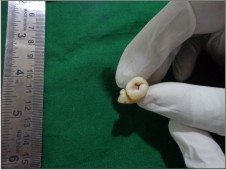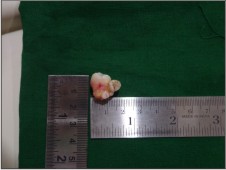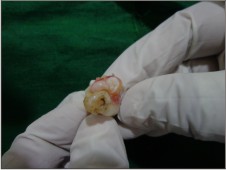Introduction:
Agglomerated masses are often noticed as an accidental finding in dental radiographs as fused odontogenic structures. They are often mistaken for odontomes during the radiographic evaluation. This may be attributed to the limitation in the conventional radiography which provides a 2 dimensional representation of 3 dimensional tissues. Agglomerated masses of fused supernumerary teeth are most frequently located in the maxillary incisor region (64.3%).56-60% of premaxillary supernumerary teeth cause impactiondue to a direct obstruction for theeruption tipping of adjacent teeth towards the place of the impacted tooth, narrowing of the dental arch, displacement of the permanent teeth bud, ormalformations of the unerupted tooth root.1
Hamartomas of aborted tooth formation, which account for 22% of the odontogenictumors, may resemble a fused odontogenic masses. The term “odontoma” was coined by Paul Broca in 1867. In 2005 WHO classified odontomes in complex and compound based on their histological criteria. Compound odontomas manifest as a regularly shaped, solitary or multiple small tooth-likedenticles, where all dental tissues are represented in a structural and more orderly pattern. Eruption of an odontome in oral cavity is very rare. Odontomes are normally discovered during second and third decade of life. Majority of odontomes occurring in anterior segment of jaws are compound types (61%)2. Sometimes agglomerated masses secondary to fusion of multiple teeth may be encountered and they may resemble compound odontomes in radiographic and morphological examination. The characteristic morphology of the fused crowns in the odontogenicmasses help in differentiating the masses from compound odontomes.
Case Report:
A 49 year old patient reported to Department of Oral Medicine and Radiology with the chief complaint of pain in left upper premolar region.
Clinical examination revealed a bony hard swelling measuring about 1x 1cm in dimension which was tender and partially erupted 25was noticed.Fig 1
 | Fig .1 Intra Oral
 |
Panoramic radiographic investigations revealed single well defined radiopaque mass evident over the tooth bearing region of maxilla in relation to 24,25 region surrounded by a rim of radiolucency. Further investigations through CBCT revealed multiple super numerary teeth. The mass was irregular in shape and continuous with partially erupted premolar. Surgical procedures revealed a mass morphologically similar to the fused tooth structure. Fig 2,3,4,5,6
 | Fig 2 Panaromic Image Showing Radiopaque Mass Surrounded By Rim Of Radilolucency.
 |
 | Fig. 3 Cbct Image Showing Irregular Mass
 |
 | Fig. 4
 |
 | Fig. 5
 |
 | Fig. 6
 |
Review Of Literature:
Development of the tooth is a continuous process with a number of physiologic growth processes and various morphologic stages interplay to achieve the tooth's final form and structure. Interference with the stage of initiation, a momentary event, may result in singleor multiple missing teeth (hypodontia or oligodontia respectively) or supernumerary teeth.2 Failure of the eruption of supernumerary teeth is a common dental anomaly and may be attributed due to geneticor environmental factors, including physical and biological factors.3
Supernumerary teeth can affect the normal position and eruption of adjacent teeth and often require clinical intervention (Harris and Clark, 2008).Supernumerary teeth in the premaxillary region arebroadly of two types: one containing teeth of normal morphology known as supplemental teeth and the other of abnormal shape.1
The etiology of hamartomatous mass remains unclear. It may be related to various pathologic conditions like local trauma, inflammatory and infectious process or due to hereditary anomalies, odontoblastic hyperactivity or alterations in genetic component responsible for controlling dental development.4
Odontomes which are hamartoma are described by the World Health Organization defines odontomas as being of two types complex and compound types based on histologic criteria. Compoundodontomas manifest as a regularly shaped, solitary or multiple small tooth-like denticles, where all dental tissues are represented in a structural and more orderly pattern and complex odontomasare malformation in which all dental tissues are present, but arranged in a more or less disorderly pattern. 5
Discussion:
In our case report there was partial eruption of the mass resembling crown of premolar. The mechanism of agglomerated mass eruption appears to be different from tooth eruption because of lack of periodontal ligament and root6. Although there is no root formation in agglomerated mass its increasing size may lead to the sequestration of overlying bone and hence results in occlusal movement or eruption.7
The morphological appearance of the mass justified to the fusion of multiple teeth. A thin radiolucency resembling pulp canal was evident in radiograph. The agglomerated mass exhibited the morphology of crowns resembling premolar, molars and super numerary. The grey scale values as observed in CBCT suggestive of hard tissue mass.
Apart from the agglomerated mass the presence of multiple unerupted super numerary teeth in the radiograph was evident in maxilla. The possibility of Gardner's and Cleido Cranial dysostosis was ruled out based on clinical grounds.
Treatment of odontomas is conservative surgical excision followed by histopathological analysis for confirmatory diagnosis 8.
Conclusion:
Hamartomatousmal formation is frequently evident in the jaw bones. They rarely erupt in the oral cavity and tend to be associated with impacted teeth. The reported case is an unusual presentation which needs to be considered in the differential diagnosis of super numerary teeth and compound composite odontomes. The need for 3 dimensional imaging is emphasized for future evaluation of such lesions.
References:
1. Raghavendra M. Shetty ,Uma Dixit .Impaction of the Maxillary Central Incisor Associated with Supernumerary Tooth:Surgical and Orthodontic Treatment
2. Fazliah SN. Supernumerary tooth: report of a case - Archives of Orofacial Sciences (2007) 2, 54-58.
3. Anastasia Fardi AthenaKondylidou-Sidira.Incidence of impacted and supernumerary teeth-a radiographicstudy in a North Greek population.Med Oral Patol Oral Cir Bucal. 2011 Jan 1; 16 (1):e56-61.
4. Amado CS, Gargallo AJ, Berini AL, Gay EC. Review of 61 cases of odontoma: Presentation of an erupted complex odontoma. Med Oral 2003; 8:366-73.
5. SE Shekar, Roopa S Rao .Erupted compound odontomeJ Oral Maxillofacial Pathol 2009 Jan;13(1):47-50.
6. DuaNisha ,KapilaRishabh. An Unusual Case of Erupted Composite Complex Odontoma Journal of Dental Sciences and Research Vol. 2, Issue 2, Pages 1-5.
7. Vengal M, Arora H, Ghosh S, PaiKM.Large erupting complex odontoma: A Case report. J Can Dent Assoc2007;73:169-72.
8. Masayyuki Kaneko et al. Micro radiographic and microscopic investigation of a rare case of complex odontoma. Oral Surg Med Oral Pathol Oral Radiol Endod1998; 85:131-134. |